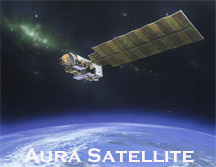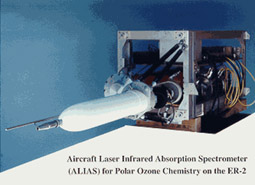Measuring Chemical Climate Changes
Carbon dioxide levels in the atmosphere, as measured from gas bubbles trapped in ice cores, has increased since the start of the industrial revolution in the 19th century from about 280 to around 380 parts per million (by volume). Direct measurements over the last 30 years show an average increase of 1.5 ppm/year. Much of this increase, which contributes to global warming, is the result of burning fossil fuels and to some extent deforestation. Total carbon content in the Earth system is held in three main reservoirs, the atmosphere, the ocean, and the terrestrial biosphere (see the Global Carbon Cycle for more information on these sinks).
Besides carbon dioxide there are other gases, such as methane, ozone, and of curse water vapour which have a role to play in the greenhouse effect. Unlike carbon dioxide, the concentration and distribution of these gases are highly dependent on physical and chemical reactions in the atmosphere. In the lower part of the atmosphere, the concentration of methane depends on the rate of its destruction by the hydroxyl radical. The concentration of ozone depends on various short lived precursor gases (carbon monoxide, oxides of nitrogen, and non-methane hydrocarbons) and transport from the stratosphere.
Chemical Climate Changes In The Ocean
The international community has been developing a global observing system for ocean carbon over the last 10 years, using ships, buoys, and satellites to understand how the ocean absorbs atmospheric CO2. This system, in conjunction with other field programs and monitoring stations, is being adapted to look at other chemical climate changes in the carbon system as well as ecosystem parameters to provide the necessary data for studying ocean acidification. Other areas requiring an adapted field monitoring strategy include coral reef sites and areas with naturally low pH, such as upwelling areas and hydrothermal vents.
Under NOAAs Coral Reef Conservation Program there is a Coral Reef Watch (CRW) Satellite Bleaching Alert. This gives scientists critical advance warning on coral bleaching to develop response strategies and minimize additional stress to reefs.
A new satellite, Aquarius is schedule to be launched in 2009 and will measure global sea surface salinity (SSS). Its instruments will measure changes in SSS equivalent to about a “pinch” (i.e., 1/6 of a teaspoon) of salt in 1 gallon of water. By measuring SSS over the globe with such unprecedented precision, Aquarius will answer long-standing questions about how our oceans respond to climate change and the water cycle. Aquarius will collect as many sea surface salinity measurements as the entire 125-year historical record from ships and buoys. It will provide measurements over the 25 percent of the ocean where no previous observations of chemical climate changes have been made.
Scientists employ a range of techniques to study ocean acidification including laboratory experiments, the use of mesocosms, and more recently, field experiments as seen in the images below. Scientists also need to investigate to what extent, and at what rate, species and ecosystems will be able to adapt to chemical climate changes, either physiologically, ecologically or by evolutionary processes.
A 10 foot diameter buoy to monitor ocean acidification was launched in the Gulf of Alaska by the National Science Foundation (NSF) in June 2007. The buoy is anchored in water nearly 5,000 meters deep and transmits data via satellite. Buoy instruments will measure the air-sea exchange of carbon dioxide, oxygen, and nitrogen gas in addition to the pH, a measure of ocean acidity, of the surface waters. This is the first system specifically designed to monitor for ocean acidification.

1. Laboratory experiments at PML looking at larval development under future CO2 scenarios.
2. Mesocosom set up in Bergen (Norway) with different CO2 concentrations.
3. The Free Ocean Carbon Experiment (FOCE) apparatus on the floor of a test tank. This device maintains a lower pH state in the interior of the array to monitor the effects of increased CO2 in the ocean. Image: Bill Kirkwood
Sourced from: EUR-OCEANS Knowledge Transfer Unit, hosted by the GLOBEC IPO at Plymouth Marine Laboratory.  Chemical Climate Changes In The Atmosphere
Chemical Climate Changes In The Atmosphere
Satellite-based ozone-measuring instruments can measure ozone by looking at the amount of ultraviolet absorption reflected from the Earth’s surface and clouds. Some instruments provide data within the different levels of the atmosphere. The Total Ozone Mapping Spectrometer (TOMS) maps the total amount of ozone between ground and the top of the atmosphere. You can view the latest ozone data at the NASA Ozone Hole Monitoring site.
The Aura satellite which was launched in 2004 helps scientists understand how atmospheric composition affects and responds to Earth’s changing climate. This satellite is assisting in revealing the processes that connect local and global air quality. The satellite tracks the extent of Earth’s protective ozone layer and carries four instruments, each designed to survey different aspects of Earth’s atmosphere. The instruments provide an unprecedented and complete picture of the composition of the atmosphere. Aura surveys the atmosphere, troposphere, and the stratosphere, where the ozone layer resides and protects life on Earth.
Aura’s four instruments, the High Resolution Dynamics Limb Sounder (HIRDLS); the Microwave Limb Sounder (MLS); the Ozone Monitoring Instrument (OMI); and the Tropospheric Emission Spectrometer (TES) all work together to provide measurements to help answer important climate questions.
 There are numerous instruments measuring chemical climate changes that are either ground based, carried on aircraft or on satellites.
There are numerous instruments measuring chemical climate changes that are either ground based, carried on aircraft or on satellites.
The Aircraft Laser Infrared Absorption Spectrometer (ALIAS) instrument is a high resolution four-channel scanning Tunable Diode Laser (TDL) and Quantum-Cascade (QC) laser spectrometer (3.4 to 8 µm) that makes direct, simultaneous measurements of (e.g. HCl, NO2, CH4, N2O, CO, water isotopes) (including vertical profiles of the tracers) in the stratosphere and troposphere at sub-parts-per-billion sensitivities. The whole instrument weighs 160 lbs. The measurement technique is based upon using TDL and QC lasers operating from 3.4 to 8 µm scanning over absorption lines recorded using second harmonic absorption spectroscopy over an 80-m path length in a 1-m multi pass optical cell of the Herriott design. ALIAS has flown over 300 times in 7 major NASA missions: AASE-II, SPADE, STRAT, ASHOE/MAESA, POLARIS, SOLVE, and CRYSTAL-FACE.
